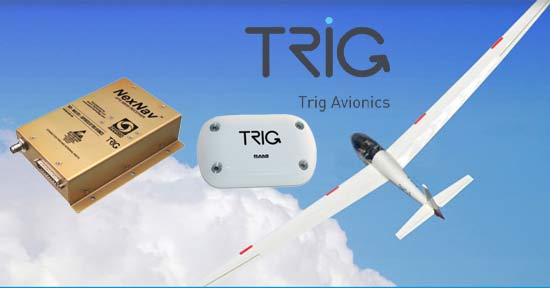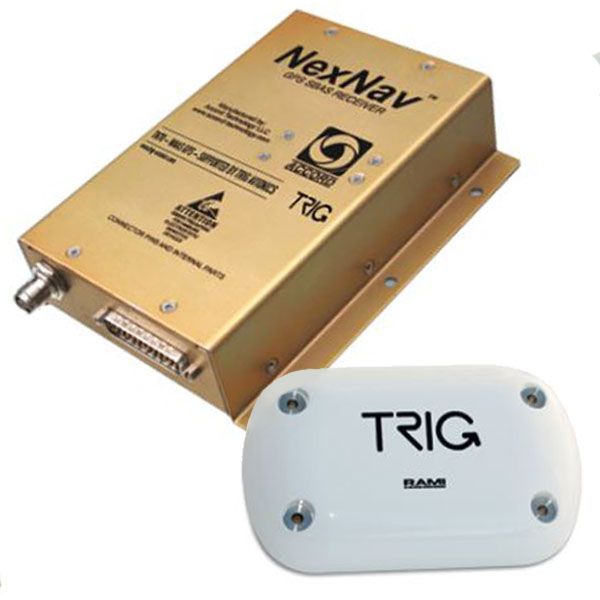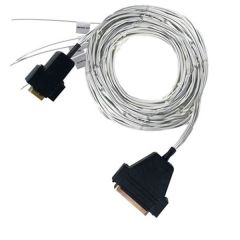Creating an account has many benefits:
- See order and shipping status
- Track order history
- Check out faster
Trig TN70A GPS Receiver


General Description
Trig TN70A GPS Receiver - If you’re an aircraft owner looking for a fully compliant ADS-B Out solution, (usually in mandated airspace) then the TN70A is the ideal partner for a Trig transponder. The TN70A is simple to install and provides a great way to add a certified FAA TSO-C145 WAAS GPS receiver to complete your ADS-B Out installation.
Trig produces smart, affordable and future proof avionics. If you’re an aircraft owner looking for an affordable ADS-B Out solution with superior performance then Trig has the right ADS-B solution to get you equipped today.
If you already own a suitable Trig transponder then adding our TN70 is the easiest way to become ADS-B compliant. The TN70 includes a certified WAAS GPS and companion WAAS GPS antenna, designed to enhance your aircraft via a simple install that will deliver excellent ADS-B Out performance. The TN70 takes no panel space, it is fitted discretely as a stand-alone GPS so you can retain and use your existing panel equipment.
If you need a Trig transponder to complete your TN70 ADS-B solution, then simply add one of our class leading transponder products (certified to FAA TSO-C166b, the latest ADS-B standard).
A Trig transponder is the hub of an ADS-B Out system, using ‘extended squitter’ to communicate with ground stations and suitably equipped aircraft. It’s worth remembering; if you intend to use ADS-B In for access to traffic information then a compliant ADS-B Out system must be installed. A Trig transponder is an ideal way to ensure your ADS-B Out is compliant.
Trig transponders use 1090ES technology - the ICAO ‘International Standard’. A Trig system not only gives freedom to travel but it also has superior capabilities, 1090ES is required above 18,000 feet so it’s suitable for use in a wider range of aircraft types than UAT.
W&W typically stocks Trig TN70A GPS Receivers.
| Specification | TN70A GPS Receiver |
| Type | SBAS – supports EGNOS, GAGAN, MSAS and WAAS |
| Certification | TSO-C145c, Beta 1 Receiver |
| Compliance | DO-229D, DO-178B level C, DO-254 level C D0-160F |
| Supply voltage (DC) | 9-32 Volts |
| Typical consumption (at 14v) | Typical: 0.2 Max: 0.3A |
| Operating temperature | -55°C to + 70°C |
| Operating height | 110,000 feet |
| Cooling requirement | no fan required |
| Weight | 1.06 lbs |
| Dimensions (inches) | 1.6” x 4.13” x 6.5” |


ADS-B OUT


ADS-B OUT AND ADS-B IN
This illustrates aircraft operating within a full ADS-B environment. Note that ground services are only available in the U.S. (these include weather and traffic services).


ADS-B uses a Trig transponder, typically combined with a GPS, to transmit highly accurate positional is information to ground controllers and also directly to other aircraft. This transmission is known as ADS-B Out and its accuracy is greater than using conventional radar surveillance. This gives air traffic controllers the potential to reduce the required separation distance between aircraft that are ADS-B equipped.
ADS-B is seen as being vital to maintaining future efficient airspace management in busy airspace. It also provides advantages in remote ‘non radar’ areas too – here suitably equipped aircraft, with a traffic receiver connected to a display can see other aircraft without conventional radar coverage. This enhances aircraft visibility and reduces the risk of air to air collision.
ADS-B uses satellite and transponder technology to provide the following benefits in an ADS-B environment:
More aircraft can operate safely in the same airspace, so congestion is reduced.
ADS-B technology enables more direct aircraft routing – this can generate significant time and fuel savings.
With appropriate equipment it’s possible to have a live ‘traffic picture’ in the cockpit.
ADS-B enhances flight safety and collision avoidance.
Aircraft with ADS-B Out provide air traffic controllers with ‘pin point’ positional and flight information data. Trig supports 1090ES, the ICAO international standard for ADS-B that can be used throughout the world.
- EASA Form One
- TA70 certified Antenna
- Installation kit:
Connector, coaxial TNC straight (1) 00723-00
Connector, coaxial TNC right angle (1) 01383-00
Headshell, 25 way (1) 00726-00
25 way D-type, Female (1) 00866-00
Crimp Terminal, Female, 22-24 AWG (14) 00730-00
Experimental Glider


Certified Glider


What else will I need to be ADS-B compliant?
The TN70 certified GPS reciever provides a compliant position source for your ADS-B Out system. A Trig transponder will also be required – this acts as the hub of your ADS-B Out solution transmitting data to ground stations and other aircraft (which are ADS-B equipped). In the U.S. FAA FAR 91.227 requires your installation to be capable of identifying the correct phase of flight – this demands some means of Air-Ground determination. Our STC provides a simple means to meet the regulations using the latest transponder software with automatic air ground, this removes the need for a squat switch or air ground switch.
What certification does the TN70 hold?
The TN70 has FAA TSO certification, in most regions the TN70 will require an installation STC. Check our STC section for the latest approvals.
What are the key benefits of an aviation GPS source like the TN70 or TN72 compared to a consumer GPS receiver?
With good satellite coverage, both will give an accurate position fix – they use the same technology and the same GPS satellite sources. The big difference is how they behave when coverage is poor or lost. A consumer GPS will estimate a position and trajectory for some time after losing satellite data. That gives the user apparent continuity when driving under bridges, or walking past tall buildings, but that behaviour is not suitable for safety critical applications, especially in a dynamic 3d environment like an aircraft. An aviation GPS will perform fault detection and exclusion to remove poor satellite data from any position solution, and will report loss of position integrity or loss of position very quickly. That appears to users that the aviation GPS is “worse” than the consumer GPS, since it gives up reporting a position when the consumer GPS keeps running. That is a deliberate safety design decision.
Why does my certified GPS take longer to find a position fix than my uncertified handheld device when I switch them both on?
Once it has locked on to the satellite transmissions, any GPS receiver needs data on the position of the satellites – called ephemeris data – to calculate the receiver position. Each satellite transmits its own data every 30 seconds. It takes 18 seconds to send the ephemeris data and the other 12 seconds in the cycle contains data about the rest of the satellite constellation. Depending on where in the 30 second cycle the satellites were when the receiver was switched on, it could take between 18 and 30 seconds to acquire the ephemeris data. The downlinked data has parity bits for error detection, but does not support error correction or higher integrity checks. For a safety of life application like aviation, the solution is that a certified receiver must hear the same ephemeris data twice before it is allowed to use it. This means a minimum acquisition time for each satellite of 48 to 60 seconds. Total time will be longer than this taking into account system initialisation, interference, and other environmental factors, but a fix after a minute or so is normal. So how does an uncertified GPS beat that? The first speed gain is simple – consumer GPS doesn’t wait for the second copy of the ephemeris data, it simply believes what it was told the first time. As a result, it can have a position fix in between 18 and 30 seconds. But an even quicker solution is available to a GPS built into a phone or anything else with a data link – instead of waiting for the ephemeris data to be transmitted slowly from the satellite, it fetches the same data from an online server. With a good data connection like a 3G phone, it might take only 1 or 2 seconds to receive all the ephemeris data over the line, and then a GPS position can be determined in less than 5 seconds.
How heavy is the TN70?
The TN70 is light weight unit – the hardware box weighs 1.06 lbs and the antenna weighs 0.31lbs.
Can I buy the TN70 without the antenna?
The TN70 comes with an antenna as a bundled kit, optimised for the best results. We do not sell the TN70 as a stand alone unit.
When I purchase a TN70 what comes in the box?
The TN70 kit comes with WAAS GPS hardware unit, matching WAAS antenna and installation kit. The TN70 installation instructions are online only.
In the U.S. if I want to fly in 2020 rule ADS-B airspace in an LSA, experimental or home built do I need a TN70?
Light-sport, experimental and homebuilt aircraft can all use the TN72. With a Trig TT31 or TT22 transponder, this meets the GPS Position Source requirements of FAR.91.227 and is 2020 compliant.
Certified Glider
Features
- SBAS GPS receiver – kit includes Trig’s TA70 antenna
- Supports EGNOS, MSAS, GAGAN and WAAS – Satellite Based Augmentation Systems
- Meets TSO-C145 – compliant for 2020 ADS-B
- Complete your ADS-B Out solution
- Requires no panel space – lightweight and easy to install
- Compatible with Trig transponders
| Product/ Model | Type | Supply Voltage | ADS-B 2020 Compliance (US) | Does this GPS come with the TA70 certified antenna? | Part Number |
| TN70A | SBAS | 9-23V | Yes – the TN70 will enable ADS-B Out and meets the latest FAA requirements. | Yes | 02466-00 |


























